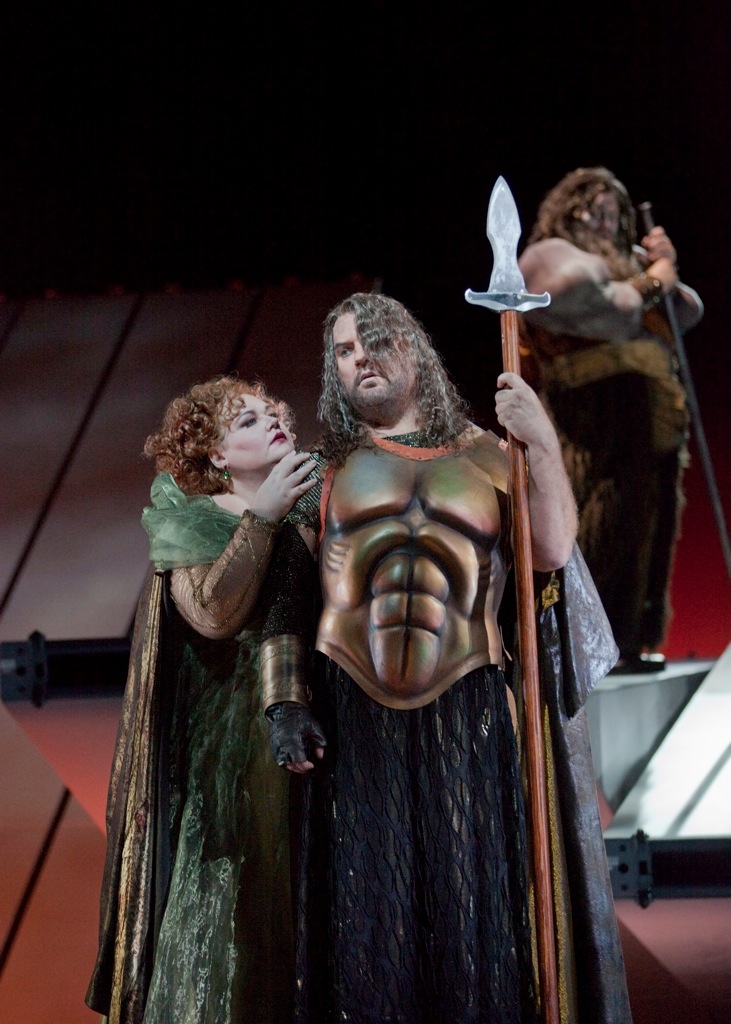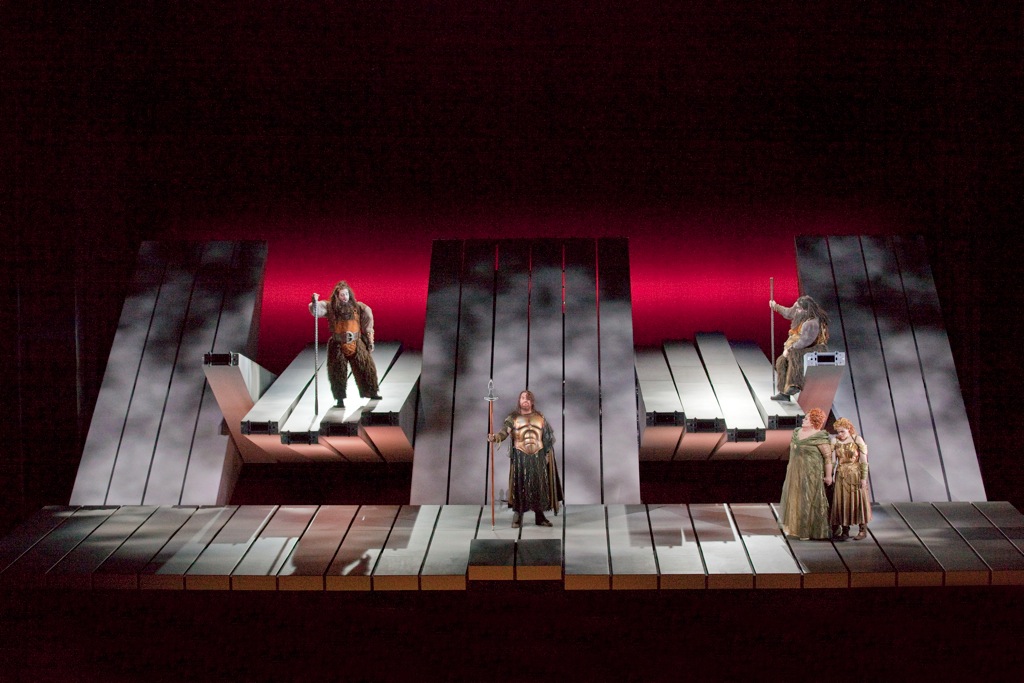Technical wizardry of Met’s new “Rheingold” serves Wagner’s vision well

Stephanie Blythe as Fricka and Bryn Terfel as Wotan in the Metropolitan Opera's new production of "Das Rheingold." Photo: Ken Howard
No Rhinemaidens were crushed by the 40-ton set at the opening night of Robert Lepage’s new production of Das Rheingold, despite a flurry of ominous press articles in the run-up to the Metropolitan Opera Season Opening Gala.
Amid all the coverage focusing on the size, cost and technical wizardry of the set – a series of moveable planks attached to a central axis that could be configured by turns into a staircase, a riverbed or a giant pair of hands – one might have been forgiven for expecting a Cirque du Soleil extravaganza set to a distant soundtrack by Wagner. But Monday night’s performance, led by James Levine and featuring Bryn Terfel and Stephanie Blythe as the divine power couple, was ultimately memorable for its focus on telling a story with all its human and musical drama.
Not that there weren’t spectacular coups de théatre, such as the descent of Wotan and Loge into Niebelheim, acted out by a pair of body doubles wearing special gravity-defying costumes who walked down an enormous floating staircase, the planks fanned out like a winged Calatrava building. The sight of the Rhinemaidens, gracefully sung and acted by Lisette Oropesa, Jennifer Johnson and Tamara Mumford, suspended before a backdrop that changed from liquid blue to riverbed pebbles, elicited gasps of admiration from the audience.
Other scenes were less successful: when the giants appeared on a pair of outstretched hands, demanding their due wages from Wotan, the effect was more of a pair of double flak cannons aimed at the auditorium. At times, the temptation to play with the smooth, tilted surface of the set in backdrop configuration proved too much for Lepage, who had one character after another slip, slide and tumble down the slope – a nice comic touch in the case of Alberich being teased by the Rhinemaidens, but ridiculous when Freia made her entrance shooting belly-down into center stage.
The striking costumes by Francois St-Aubin – some of them wired so they could be lit from within – were a mix of traditional shapes and futuristic materials. The giants were imposing figures in terrifyingly large codpieces and wild, matted dreadlocks; the Rhinemaidens alluringly slinky in fishnet bustiers. Wotan hid his missing eye behind a mane of long wavy hair – a kind of Samson before the snip.

Photo: Ken Howard
This is only Terfel’s second Wotan, following a 2005 role debut at Covent Garden, and after a somewhat hesitant beginning, his voice gained its characteristic warmth and expansiveness. His German diction is impeccable and he is a committed actor. In Rheingold, Wotan reacts to events more than he shapes them, but the openness of Terfel’s Wohan to the characters around him – his wife’s entreaties on behalf of her sister, Fafner’s stern admonishment to heed his laws, Loge’s eminently human practicality – is not portrayed as a weakness but rather the mark of a thoughtful ruler. The chemistry between him and Fricka is tangible and anchors his character throughout the ups and downs of the opera.
Stephanie Blythe inhabits the role of Fricka with consummate dignity. In her hands, Wotan, unsel’ger Mann became an almost Purcellian lament, as the grief of human desire and need seeps into the world of the gods. The green blinking light emanating from her bodice in this scene was wholly unnecessary and no match for her vocal acting skills. Her voice continues to be a marvel, rich and flexible in the upper register, glowing like polished mahogany in the lower range. The power of her voice never appears forced and she seemed to relish pitting it against a full-throttle orchestra.
To the role of her younger sister Freia, Wendy Bryn Harmer brought a sense of innocence and ingenuity and a bright, sometimes brassy soprano. Patricia Bardon’s Erda was an otherworldly apparition, delivering her warning of the Ring’s cursed power with a fluid, haunting tone.
Of the male roles, Richard Croft as Loge offered the weakest vocals. Bathed in a flickering golden light for much of the evening, and wearing gloves with fingertips that lit up, his voice did not quite stand up to the heat. He sings with a sweetness of timbre and purity of phrasing but is better suited to different repertoire.
The German basses Franz-Josef Selig and Hans-Peter König owned their roles as Fasolt and Fafner with biblical authority. Selig played Fasolt with a depth and nuance of feeling that revealed the human anguish behind the bluster. Adam Diegel, making his Met debut as Froh, was a revelation, his voice lush and vigorous, a true heldentenor in the making.
Gerhard Siegel threw himself into the role of Mime with heart and soul. The scene in which he is tormented by Alberich–sung with menacing intensity by Eric Owens–was a showpiece of vocal acting and fearless physical comedy.
Making his return to the orchestra pit after a long illness-induced absence, James Levine conducted with great energy and vigor, drawing thrilling performances from a highly motivated orchestra. When he appeared on stage at curtain call, frail and barely able to bow, the applause was thunderous.
There were vociferous boos among the bravos for Lepage. Yet detractors of the gargantuan set might pause to consider the effect it had on the singing, acting as a powerful resonator that projected the voices into the auditorium, allowing the singers to explore subtle nuances and variations in timbre. In the few instances where singers were placed to the side or above the set, such as Wotan’s first appearance or Dwayne Croft’s Donner pointing the way to Valhalla, the loss of resonance was starkly felt.
New stage techniques such as interactive projection, which allowed air bubbles to rise from the Rhinemaidens, triggered by their actual voices, or pebbles to slide under the movement of their fishtails, are not gimmicky when they are such an extension of the singers’ performance – and of the music. With a score so full of onomatopoeic orchestration, of clanging anvils and Rhine-gurgling clarinets, Wagner’s Ring comes with “special effects” built in – and it takes more than a 90,000 pound hydraulic set to upstage them.
Das Rheingold will be repeated September 30, October 4 and 9 and March 30. metoperafamily.org; 212-362-6000.
Corinna da Fonseca-Wollheim is an arts journalist in New York City. Her articles on music have appeared in The Wall Street Journal, The New York Sun, The Jerusalem Post and Symphony magazine.
Posted Oct 10, 2010 at 3:16 am by Peggy Czyzak-Dannenbaum
This is by far the most interesting review I have read. In addition to meaningful comments on both singing and acting, it was the only one to comment not only on the visual aspect of the set but the way that it serviced the singers. Her negative comments were spot on as well and one hopes, and expects, that once the technical aspects of the set are fully mastered this will be the Ring that captures Wagner’s intent better than any (with the possible exception of Wieland’s in Bayreuth.